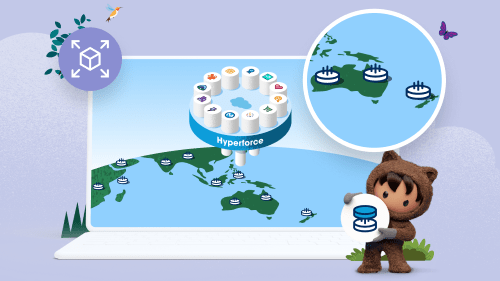The New Evolution of Digital Transformation for the Insurance Industry



The insurance industry has been shouting about innovation and digital transformation for years but the reality is weighed down by legacy technology and often culturally entrenched resistance to change. Here’s how Salesforce’s acquisition of Vlocity is changing that.

Sascha Ambrose
The insurance industry has seen an explosion of new digital-direct players entering the market over the past few years. And traditional insurance companies are starting to feel the effect. So how do you convince insurance executives that the need for digital transformation is greater than the challenges of tackling their complex legacy IT landscape?
Show them there is an opportunity to fast track digital transformation within the insurance industry. Salesforce’s acquisition of Vlocity, designed for Property and Casualty, Life, and Employee Benefits lines of business, is a major leap forward in tailoring software that is unique to the needs of insurers. With many insurance companies struggling with even basic digital experiences, this is big news for the industry. Let’s take a look at why.
It’s the new vertical solution
As the first and only end-to-end digital platform purpose-built for insurance, Salesforce Industries Insurance (formerly Vlocity) is game-changing for insurance companies.
Despite Salesforce CRM being a hub for customer data and being an easy platform to integrate into, it still meant that most processes from an insurance perspective were run in other systems. With Salesforce Industries Insurance, we now have the ability to bring the front and middle/back office together. Product catalogue quoting, claims management, policy administrations and more can now happen on the same platform.
If you look at one of the reasons organisations undertake a digital transformation, it is because their legacy IT is siloed. Their data is siloed. Essentially we have built bridges to connect your data, employees, and customers with the aim of creating a single, unified view of your customer. Insurance agents no longer need to work with multiple systems being open on multiple monitors using ‘swivel-chair integration’. And once you’re operating on a single platform, you’ll be able to surface insights into customer behaviour through the whole customer lifecycle and maximise the potential of new technologies including AI.
With unified data comes new insights
Looking at your business anew with the benefits of new insights and tools is what digital transformations are all about.
For Atlas, a leading insurer in Malta, it started its transformational journey when Malta became part of the European Union and was exposed to new forms of insurance. It quickly became apparent that Atlas required an agile technology platform to keep up with changing customer expectations.
With the goal to become more customer-centric, as well as future-proof their business following COVID-19, Atlas developed a direct-to-consumer online experience. In just four months, Atlas went live with a simplified direct-to-consumer Home Insurance quote-to-bind experience for two Home insurance products, shortly followed by six Motor Insurance quote-to-bind experiences. For the Atlas customer, this means they can get insurance quotes and make purchases without speaking to an agent. And for Atlas, this means straight-through processing of policy transactions and a transformative insurance process.
The Vlocity acquisition extends Salesforce’s CRM strength, using an aggregation of data at customer level, and bringing in digital-first, no-code middle-and back-office processes pre-built for the industry. And it drives faster product creation, distribution of products, and greater operational efficiencies with straight-through processing and business innovation.
In fact, for Salesforce Industries Insurance customer Ascot, it really has been transformative for their operational efficiencies.
Before Ascot brought on Salesforce Industries Insurance, they were struggling to reduce their underwriting administration time. That all quickly changed with Salesforce Industries Insurance, which reduced that administration time by nearly 60%. Using low-code integration technology, Ascot have been able to streamline their quoting and policy processing time, freeing up underwriters to spend more time on analysing the progress of their portfolios.
Customer experience is now the battleground for brands
The roll-out out of the new Salesforce Industries Insurance isn’t only a big deal for insurance IT leaders looking to dispose of legacy IT systems, it is a big deal for every executive in the company. Why? Because this type of product improves the customer experience across the entire customer value chain.
The insurance industry has never been more competitive than it is right now. If you look at the new market entrants and why they are collectively starting to have an impact on the industry, the good ones all do one thing well. They put the customer experience at the centre of everything they do. From the engagement layer, to products, to servicing and retention.
In fact, customer experience is the key battleground for insurance brands. Even in our very first State of the Connected Customer report, 68% of consumers said technological advancements would positively impact their relationships with insurance companies. Now, 53% of customers expect offers to always be personalised – up from 49% in 2019.
Customers are looking for simplicity in product offerings and dealings with insurance brands. They also want brands that deliver on their promises instantly, and offer service and support whenever they need it. They want brands that can connect with them where they are, not where the organisation tells them they should be; and that offer a seamless experience across every channel.
With omnichannel customer journeys that results in a single, seamless interaction with consumers across all channels, and speed-to-market through digital and cloud, Salesforce Industries Insurance is helping insurers transform their business to meet these new demands of customers.
Four steps to digital transformation
To make digital transformation more manageable, Salesforce has identified four steps for organisations.
- First, define simple and what that means for your organisation and customers. For example this could mean asking your customers fewer but more pointed questions to get the answers or quote customers need.
- The second is building a multifunctional team that includes the business owner, a product expert, a CX/UX designer and an information architect.
- Next is to evolve to straight-through processing. You can start small by prioritising your needs and then breaking them into phases. You also might want to consider what can be automated and where human-interaction is required.
- Finally, mandating microservices with cloud-native solutions with prebuilt insurance-specific cloud processes offers the fastest path to digital transformation. When your systems can “talk” to each other the work can flow easier.
What drives great general insurance experiences in the new normal? Read The Customer Imperative in Financial Services report for all the findings.





















